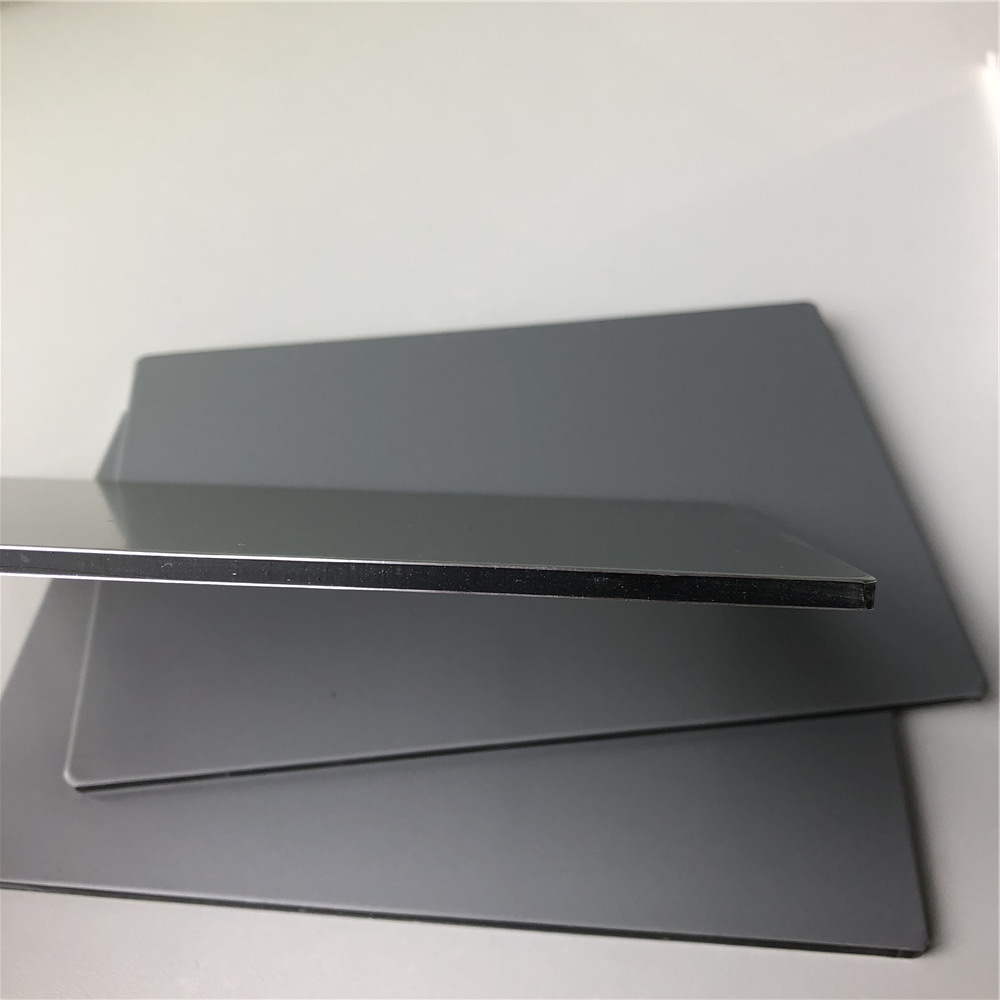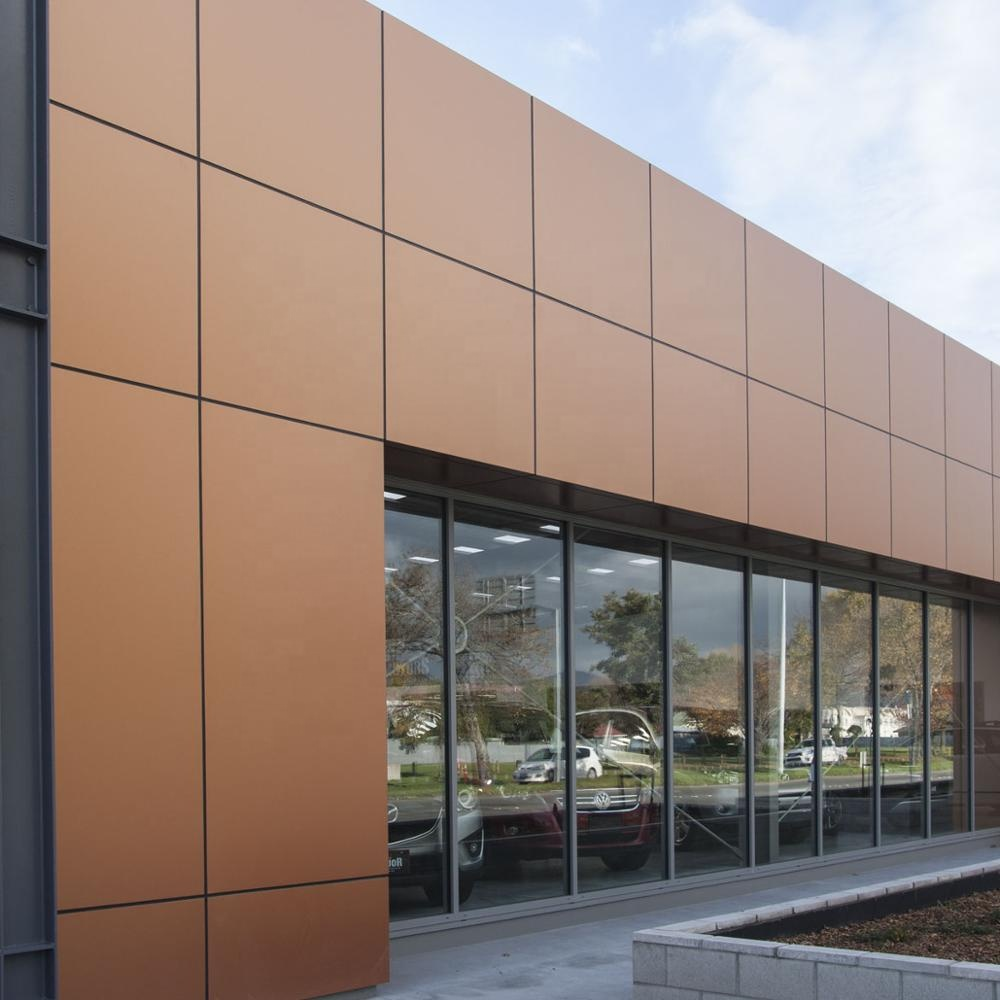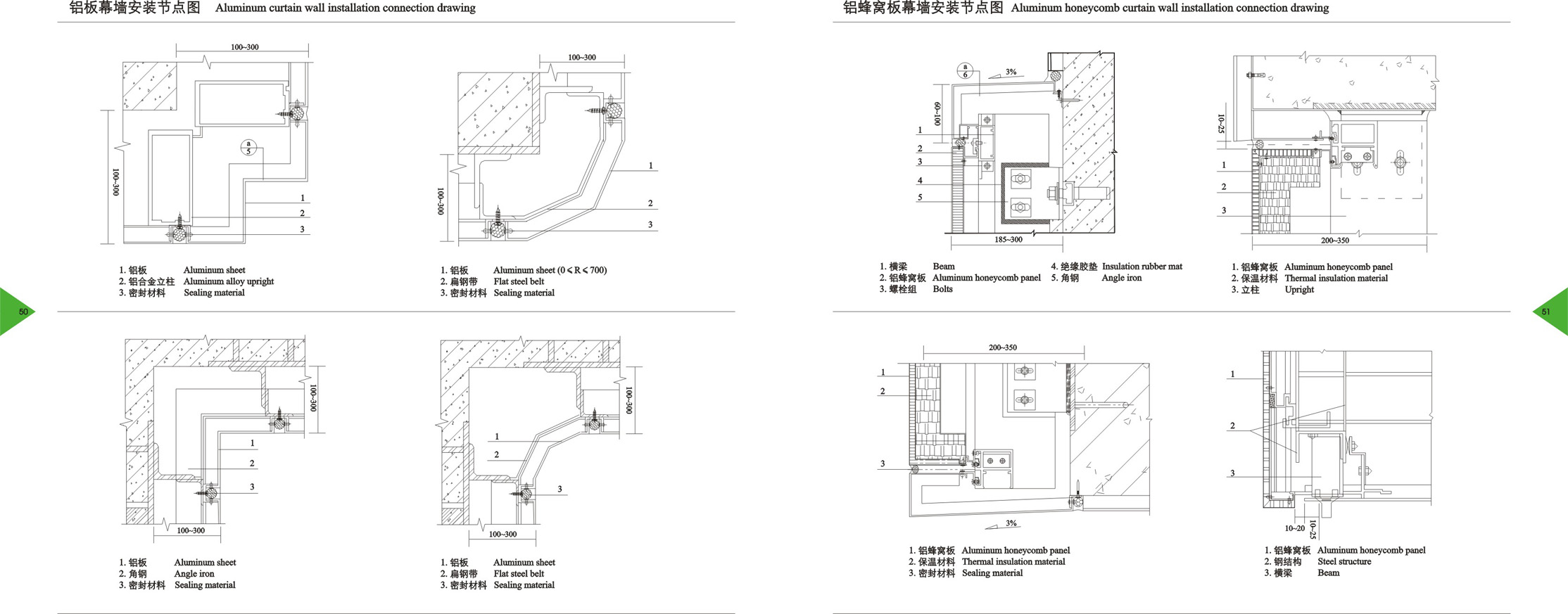Preparations before installation of ACP:
Take the standard line as the benchmark, place the ruled line on the wooden board according to the drawing, and make a mark; after the ruled line is put out, it should be checked and accepted before the next process.
Installation of connection parts: According to the grid line, the main structure is punctured and installed with expansion bolts, and the expansion bolts are fixed with the connection parts.
Keel installation: first install the columns from the bottom to the upper layer; the poles are fixed to the connector with bolts, and according to the horizontal wire, adjust the horizontal elevation position of each column, tighten the bolts slightly, then adjust the in and out positions, left and right positions, and pass the inspection. After that, tighten the nut; finally, install the horizontal keel, and install the horizontal keel for welding. The keel welding should be aligned with the meat and the weld. The wire should be pulled horizontally during installation to ensure that the interface between the vertical keel and the horizontal keel is flat and free of looseness. It is heavy and should be handled lightly to prevent collision and scratching. When hanging the material, the nut should be tightened to prevent it from falling off. After adjustment, avoid connecting the thunder copper wire. Vertical keel and horizontal keel. The galvanized layer of the joint is damaged, and the antirust paint and the silver paint are applied.
Aluminum Composite Material Panels
ACM Panels production: The depth of the ACP planing groove should be determined according to the thickness of the board. The thickness of the plastic material reserved should be about 1/4. The plastic material layer cannot be completely planed to prevent the inner surface of the surface aluminum panel from being exposed for a long time and being corroded. And if only the outer layer of the skin aluminum panel is lowered, after bending, the strength of the panel at the bend will be reduced, causing the panel to shift.
After the panel is grooved, the corners are cut according to the design, and the panel can be bent into the desired shape. When bending the board at the planning groove, try to clean up the debris. When bending, do not repeat the bending many times. The butt joints of the four corners of the board should be sealed with sealant. The edges with bristles can be trimmed with a file. When trimming, do not damage the surface of the aluminum plate. When you need to drill holes, you can use electric drills, wire saws, etc. to make holes in various shapes on the aluminum-plastic board.
Installation of ACP: Fix the aluminum composite material panels to the frame one by one with screws or bolts, leaving a gap of 10-15mm between the panel and the panel, and adjust the installation error afterward.
The installation process of ACP:
Before installation, the keel, column, and lightning protection should be checked again. After passing the specifications, the surface materials of the corresponding specifications should be put into place, and then installed from top to bottom; during the installation, the flatness of the adjacent panels and the horizontality and verticality of the panels, Use the wood board module to control the width of the seam;
When installing, it should be in place, temporarily fixed, and then adjusted by pulling the wire;
During the installation process, if there is an error in the width of the seam, it should be evenly distributed in each glue seam to prevent the error from accumulating in some seams or on a piece of surface material.
After the ACP is fixed, the indirect seam of the panels and other parts to be sealed are sealed with weather-resistant silicone sealant.
Sealing: cleaning and drying of the sealing area. When cleaning, care should be taken not to let the solution radiate to the place other than the joints. The cleaning gauze should be replaced frequently after cleaning to ensure the cleaning effect. Finally, use a dry and clean gauze to wipe the traces of the solvent after evaporation. Cloud, keep the sealing surface dry;
Glue seam trimming: After the glue is injected, the glue seam should be pressed with a small shovel along the glue injection direction to scrape off the excess glue and scrape the glue seam into the design shape to make the glue seam smooth and smooth;
Remove the paper tape: After the tape is trimmed, remove the protective tape in time, and pay attention to the tape not to contaminate the aluminum plate surface; remove the glue marks in time.
The construction thickness of the weather-resistant silicone sealant should be controlled at 3.5 ~ 4.5mm. If the glue is too thin, it will ensure the seal quality and prevent rainwater leakage. However, the glue should not be too thick, and too thick glue can be easily broken. The construction width of the weather-resistant silicone sealant is not less than twice the thickness or it depends on the actual seam width.
The Application of ACM Panels: Car Dealer Shop
Detailed requirements for installation of ACP:
Column: the deviation of the installation elevation is not more than 3 mm, the deviation of the front-to-rear direction is not more than 2 mm, and the deviation of the left and right is not more than 3 mm; The distance between the two columns is not greater than 2 mm.
Beam: The connectors and elastic rubber pads at both ends of the beam are installed at the predetermined position of the column, and they should be installed firmly, and their joints should be tight; the horizontal elevation deviation of two adjacent beams should not be greater than 1 mm, and the maximum elevation deviation of the same beam Not more than 5 mm.
The vertical deviation of vertical slits and external surface of the entire curtain wall is not more than 10 mm;
The seam width deviation is not more than 2 mm;
Curtain wall flatness is not more than 3 mm;
Cross seam straightness is 3 mm;
On-site Release
The construction staff checks whether the position and quantity of the embedded parts are consistent with the design according to the construction drawings. If there are any discrepancies, they should be promptly proposed to the owner and coordinated by the owner to make adjustments. The upper and lower control coordinates, horizontal and vertical elevations should be clearly used. The paint or ink line is marked at the appropriate position, and after the check is correct, the construction staff will organize the personnel to install the iron parts.
Iron Installation
After the iron parts are installed, the constructor and quality inspector check the position of the iron parts and the installation quality of the connecting bolts, and rework if they do not meet the requirements; the inspection can be performed before the next step.
Keel Installation
Preparation for installation
Components should be transported and not be bumped or damaged during hoisting. The components should be stacked on the dunnage. Protective measures should be taken when the boards are stacked.
The components should be inspected and calibrated before installation, and the next step can be carried out without errors.
Keel installation
A three-person team is adopted. One person in the lower plane controls the pulley crane. Two persons in the lower plane hold the keel to an appropriate position. After it is in place, it should be corrected and fixed immediately. The components completed on the day should form a stable space system.
The connectors and elastic rubber pads at both ends of the keel are installed at predetermined positions and should be inspected, adjusted, corrected, fixed, and meet quality requirements.
Other accessories installation
The keel is installed and in place, and it should be tightened in time after adjustment. The temporary bolts should be installed, adjusted, and tightened in time after the component is installed.
After the keel is fixed, the rusted area of the keel aluminum-zinc layer should be treated in a timely manner.
After the installation is completed, the quality inspector and the construction engineer can check the operation before proceeding to the next step.
Seal:
The construction thickness of the weather-resistant silicone sealant is greater than 3.5mm, and the construction density is not less than 8mm. The bottom of the deeper sealing notch should be filled with polyethylene foam.
Weather-resistant silicone sealants should be allowed to form opposite sides in the joint. It must not be available on three sides.
Installation and Connection Drawing of ACP and Aluminum Honeycomb Panels
Completion cleanup
After the installation is complete, remove the surface dirt. The construction site was cleaned up, and the quality inspectors of the branch conducted a comprehensive inspection of the entire project and made a record.










